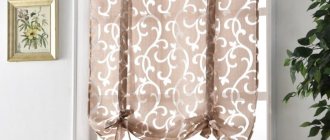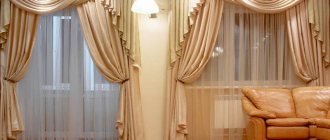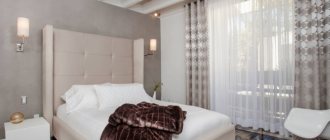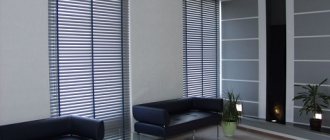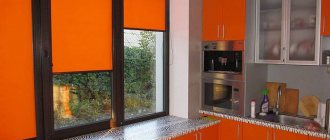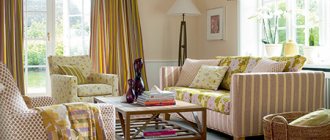Repair and decoration
04/15/2018 Anastasia Prozheva
Curtains are the frame of the room, which can create half the mood along with the wallpaper on the walls. The choice of this decorative item is the most important issue, which must be approached seriously and wisely.
Curtains are an important element in a room, so when choosing them you should pay attention to the color, texture, and composition of the fabric.
The difficult task is often what fabric to choose for curtains. Indeed, today many materials suitable for sewing curtains are produced. And not only the degree of illumination of the room, but also the well-being of the people in it will depend on their naturalness and quality.
There are a lot of tips on choosing material for curtains. But they all fall into several categories. Agree that a lot depends on which window the curtains will be hung on and what level of illumination will be obtained in the room being decorated.
Selecting textiles depending on the room
It's no secret that with the help of curtains you can visually adjust a room, add height or width. This is the first thing you should pay attention to. If the room has low ceilings, as is often the case in old houses, it is best to avoid massive lambrequins and heavy, heavy fabrics. Light curtains and straight curtains made from natural fabrics are more suitable. High halls with narrow windows are best decorated with luxurious curtains that fall down in waves. Geometric stripes on curtains matter.
Horizontal lines expand the room by pushing the visual boundaries of the window to the sides
Vertical lines give the impression that the room is higher than it actually is.
The lighting and orientation of the room are of great importance. Northern windows will never be exposed to intense insolation, so fabrics that are sensitive to sunlight can be used here. The fabric should not be too dense, light in color and not burden the appearance of the window. It is better to decorate southern and eastern windows with curtains that have a low solar penetration rate. It is better to dilute the composition of heavy curtains with light tulle.
You should definitely consider the purpose of the room for which you are choosing curtain fabric. If this is the living room,
Curtains for the living room
Pay great attention to noble, expensive textiles. This is the room where guests are received and it should be harmoniously and carefully decorated. Beautiful curtains with a lambrequin in combination with tiebacks and other accessories will help with this.
If the curtains are intended for the kitchen, you should take into account the large amount of fumes and the high probability of getting them dirty as soon as you hang them. You need to choose a fabric that is resistant to frequent washing and not too picky to care for. Here it is worth paying attention to light colors that do not block light from entering the room.
Curtains for the kitchen
Natural fabrics or synthetic. How to choose fabric for curtains?
The dilemma in choosing suitable curtains is the quality of the textiles. It is a mistaken belief that you need to choose only natural fabrics. Each has its own advantages and disadvantages. Natural curtains look very aesthetically pleasing, elegant, add luxury to the room and immediately attract attention. But, unfortunately, such material is too sensitive to the sun and mechanical influences. In a few years, it will become very frayed and fade, and its former beauty will go away along with the tidy sum that you will have to pay for such fabric. Moreover, such textiles are more difficult to sew with your own hands, since delicacy is one of the features of natural fabrics. But you can’t get too carried away with synthetics either. Of course, it looks impressive, always elegant and unsurpassed, but it feels too “chemical” to the touch.
So, let's consider only a few options for the most popular fabrics from each type.
Cotton
Cotton curtains - decoration of any room
One of the most common natural fabrics among curtain textiles. You can find it in any fabric store under the names calico, cambric, satin, chintz. Sometimes the fabric is made from pure 100% cotton, but in most cases some synthetic substances are added to improve the quality characteristics of the textile. Fabric of plant origin, soft, pleasant to the touch. The material has good ventilation properties. But, as they say, there is a spoonful of honey in every barrel. Cotton fabrics hold color very poorly, so don't be surprised if the curtain turns pale after a few washes. The solution to this is to choose light natural tones, but they can also fade in the sun. Cotton wrinkles very easily and does not hold its shape.
Silk
The mesmerizing beauty of silk will not leave anyone indifferent
High-quality, expensive fabric, which is highly valued in the textile market. Natural strands provide its anti-allergenic and antifungal properties. The fabric is soft, flows from the cornice in light folds and captivates attention from the first seconds. But such beauty will most likely remain until the first wash, since the curtain may decrease in size and become wrinkled. Any stains, even from water, are very noticeable, so it is better to be careful with such curtains.
Linen
Simple and natural material in the interior looks very organic
At one time this material was very popular on the market. Beautiful relief structure, natural origin, easily breathable - all the advantages are difficult to list. The fabric does not require special care, is easy to wash and does not lose its color qualities. True, there are some disadvantages that should be taken into account when choosing this particular fabric. Curtains are always visible and it is very important that they always look neat and beautiful. But linen wrinkles so much that ironing it becomes a huge and often impossible task. Therefore, they use either compression technology, when they initially use a special crumpled fabric, or add synthetic substances to the composition. They help the product keep its shape and please the eye for a very long time.
Polyester
It is a synthetic fabric that is produced through a complex process of chemical synthesis. The fabric is widespread and popular. It holds its shape very well, shimmers beautifully, washes and irons well. The only downside, as with most fabrics, is that it doesn't feel very pleasant to the touch. When choosing fabric for sewing clothes, this would be important, but for curtains it is not a priority.
Polyester perfectly retains all the richness of colors and delights every day with bright colors. An example of 100% polyester curtains.
Acrylic
Synthetic material, which, unlike polyester, is very pleasant to the touch and soft. It has all the practical properties of synthetics - durable, does not lose shape, does not wrinkle, and even after the tenth wash it looks like new. True, after several washes, acrylic fibers form pellets, which look very unsightly and spoil the appearance of the curtains.
Acrylic fabric is always a stylish solution for curtains
Nylon
Very light and elastic fabric. Smooth and pleasant to the touch. Does not wrinkle, irons and washes well. But, unfortunately, the big disadvantage is that the fabric fades very quickly in the sun, which is not very practical for curtains. Therefore, nylon in its pure form is very rarely used for curtain textiles.
In the modern world, mixed types of fabric are preferred. Very often natural and synthetic materials are combined in order to combine beneficial properties and maximize use while maintaining the beautiful appearance of the curtains.
Depending on the type of thread weaving, the composition of natural and synthetic fabrics, the following popular options can be distinguished: velvet, brocade, jacquard, satin, chenille, organza, tulle, veil, blackout, muslin, taffeta, flock.
The local market of foreign countries can offer you different types of fabrics, but they will still be based on a natural or synthetic composition.
Basic rules for choosing fabric for curtains
Taffeta curtains do not fade in the sun and are easy to wash.
So, these were the basic parameters for choosing fabric for curtains in a well-lit room.
But besides all this, you should know the general rules for selecting material for curtains, which are universal.
Moreover, this is especially true for those who are going to sew curtains with their own hands.
Choosing a shade and pattern of curtains
Polyester curtains do not lose their color after repeated washing and are very durable.
- It is necessary to choose a material for curtains with a horizontal pattern or ornament to visually expand the window and a vertical one to visually increase its height. Ornaments diagonally or in a circle can increase the window both in height and width, or simply leave its size visually unchanged. Here a lot will depend on the size of the pattern: the larger and more voluminous the ornament is, the more it will increase the window opening.
- You need to pay attention to the main shade of the room. If the room is done in cool colors, then it is advisable to choose fabric for curtains in a tone that is slightly warmer than neutral. A too warm room can be slightly cooled with a neutral or cool shade of curtains. This way you can restore the light balance in the room.
- To prevent the room from merging into one faceless spot, you need to try to select curtains so that their tone is darker or lighter than the wallpaper. At the same time, attention is paid to the drawing. So, for a room where the wallpaper is plain, it is better to choose curtains with a bright pattern. And for a room with bright wallpaper, it is best to choose a more restrained curtain design.
- It is very important that the design on the curtains contains visible elements of the same color as individual places on the walls or floor. This way the curtains will not look alien and inappropriate in the room.
Related article: Interior arches made of plastic - finishing ideas
Functional Features
Curtains made from natural fabrics are environmentally friendly and good for use in children's rooms.
- A good option is to choose two different curtains for the same window. So, for the winter, it is most convenient to hang curtains made of thicker fabric on the window, which will create warmth in the room and not allow light wind to pass through. In this case, viscose or velvet gives a good effect. For the summer, it’s good to buy light curtains made of cotton or linen, which will slightly refresh the room, giving it more fresh air.
- When choosing curtains for any room, it is important to consider their purpose. So, if curtains are needed for protection from the sun, then special attention should be paid to the degree of fading of the material in light. If you need curtains as a decoration that will simply serve as a window frame, then you can use almost any fabric and shade.
- It is very important to choose a type of curtain fabric that can be washed without any problems. Almost all curtains on sale now are suitable for repeated washing, if, of course, it is done manually or in a delicate machine mode. But if you want to hang expensive curtains with lining, then you can forget about washing completely. Such fabrics either need to be taken to the dry cleaner, or left hanging on the window and collecting dust. Therefore, think for yourself: do you need such an expensive and impractical pleasure?
Important nuances when choosing curtains
The choice of fabric and color of curtains depends on the style of the interior, the size of the window openings, the color of the walls and wallpaper.
- Particular attention should be paid to the choice of material for curtains if the window already has horizontal blinds. Here it is important not only to choose curtains that match the overall style of the room, but also to match the color and texture of the blinds. So, for a window with blinds, it is completely unacceptable to select fabric for curtains with a strictly horizontal pattern. A strictly vertical ornament may also not look harmonious enough. It is best to choose a fabric with light colors, the shade of which will only slightly overlap with the shade of the blinds.
- If you decide to sew curtains from fabric to order or with your own hands, then first it is advisable to buy a small piece of the desired fabric, hang it on the curtain rod and see how it all looks. Particular attention is paid to drapery and shade.
Related article: Brick window casting
And at the same time, immediately check the material for practicality: wash it several times and iron it with a warm iron. If the fabric is good, it will not fade, will not lose its shade even partially when ironed, and will not provoke the appearance of scorch marks.
So, now you know how to choose the right fabric for curtains.
It is important to take into account in this matter both universal rules and those specifically provided for brightly lit rooms.
With a successful choice of curtains, you can enjoy the comfort of the room for a long time.
The best posts
- How to make a plasterboard ceiling in the kitchen with your own hands
- How to paint drywall: little tricks
- Socket boxes for drywall: correct selection and installation
- Grouting drywall joints: materials and techniques for performing the work
- Epoxy resin, application
- How to cover a radiator with plasterboard without losing heat in the room
- Repair of plasterboard ceilings: we fix the problem ourselves
- Machine for the production of profiles for plasterboard: production of frame elements
Sewing curtains with your own hands
Nylon gives the chosen color a special mysterious shade
It is very important to take into account the properties of the fabric when sewing, so you should always look at the label attached to the product. Some curtains are lined to increase their durability and improve their shape. It is important to note that you can combine different fabrics by sewing them together onto one lining.
The necessary braid can be found in any textile store, where you will be offered a wide selection depending on the size and type of your curtains.
The finished curtain can be very easily decorated with small accessories in the form of tiebacks, pins or garters. These are most often sold in curtain and tulle stores, but this does not mean that you have to buy them. If your sewing skills allow you to sew a curtain, then a small tie will be easy to handle.
Do-it-yourself grabs
This photo shows a clear example of a handmade product for your curtains that you can do yourself
You can make tiebacks from the remaining fabric or choose a darker tone, but most likely it will blend in with the curtains and your efforts will be in vain. Tiebacks with tassels woven from large threads or ropes are considered more valuable. They are made very simply and look expensive and beautiful.
Recently, a huge number of different options for designing pick-ups from improvised means have appeared on the Internet. In the digital era, it’s not at all difficult to find an old CD that no one needs at home. Its base - durable plastic of a round shape will become the basis for the hairpin. The connector in the center needs to be expanded so that the thickness of the disk is 1.5-2 cm. Then, with frequent skeins of thread of the desired color or tape (everyone can use what they find at home), the surface of the disk is covered. The composition can and should be supplemented with small flowers, which can also be made from fabric. In addition to this, you also need a hairpin, the length of which is twice the diameter of the disc. It also needs to be decorated to match our circle.
This is how simple, cheap and cheerful you can make a small beautiful accessory with your own hands.
Curtains are selected and sewn for a long time. They are usually changed during repairs, which in plain English means very rarely. That is why it is very important to choose the most suitable fabrics that can last a very long time. Modern samples offer a lot of individual solutions, each of which can be suitable for your window. All that remains for you is the choice of textiles for new curtains instead of old ones.
The finished curtain can be very easily decorated with small accessories in the form of tiebacks, pins or garters. These are most often sold in curtain and tulle stores, but this does not mean that you have to buy them. If your sewing skills allow you to sew a curtain, then a small tie will be easy to handle.
Do-it-yourself grabs
You can make tiebacks from the remaining fabric or choose a darker tone, but most likely it will blend in with the curtains and your efforts will be in vain. Tiebacks with tassels woven from large threads or ropes are considered more valuable. They are made very simply and look expensive and beautiful.
Recently, a huge number of different options for designing pick-ups from improvised means have appeared on the Internet. In the digital era, it’s not at all difficult to find an old CD that no one needs at home. Its base - durable plastic of a round shape will become the basis for the hairpin. The connector in the center needs to be expanded so that the thickness of the disk is 1.5-2 cm. Then, with frequent skeins of thread of the desired color or tape (everyone can use what they find at home), the surface of the disk is covered. The composition can and should be supplemented with small flowers, which can also be made from fabric. In addition to this, you also need a hairpin, the length of which is twice the diameter of the disc. It also needs to be decorated to match our circle.
This photo shows a clear example of a handmade product for your curtains that you can do yourself
This is how simple, cheap and cheerful you can make a small beautiful accessory with your own hands.
Curtains are selected and sewn for a long time. They are usually changed during repairs, which in plain English means very rarely. That is why it is very important to choose the most suitable fabrics that can last a very long time. Modern samples offer a lot of individual solutions, each of which can be suitable for your window. All that remains for you is the choice of textiles for new curtains instead of old ones.
Choice of matter
Materials for curtains are usually chosen taking into account a specific style. In order to sew a lambrequin with your own hands, they select a wide variety of fabrics, but most importantly, thick ones, and plastic ones - to create products with elegant decorative folds. Different materials can often be combined in various variations and combinations. But if you also take up the task of combining, you need to take into account that in this case the method of caring for curtains should be suitable for two options at once.
In order for both the texture of the material and its color to harmonize correctly with your interior, when choosing a fabric, you need to try to get home a particle of the desired material to see how it will look in the room. It must also be remembered that some materials change in color and tone depending on the distribution of light and time of day. For example, silk curtains may look green in the morning, but take on a grayish-blue tint in the evening.
The most color-resistant materials include the following:
- Satin is a shiny and smooth fabric that is perfect for the bedroom because it has a specific density in its structure, but has airy outlines in appearance.
- Velvet - this material works best in a living room or hall, creating an atmosphere of grace.
- Corduroy is a very good material, which is also used in making curtains. In addition, corduroy lends itself well to visual additions (drawings).
- Gabardine is a material considered universal. It can be multi-colored or single-colored. Gabardines come in different types: cotton, silk or wool. Therefore, the density of gabardine fabric can also be selected.
- Tapestry is the heaviest type of material. It is well suited to a living room or hall, the interior of which is made in Baroque or classical style.
- Damask is a fabric that is perfect for the bedroom. It has a permanent base into which different threads of silk or cotton are woven, making the appearance of the material lighter.
- Jacquard is a material that will be most harmoniously present in the decor of a living room. It is made by intertwining threads of various colors. Jacquard can very easily add variety to any room, but the wallpaper should be a pastel color.
- Damask is a fabric that initially has a matte or glossy pattern. It is perfect for rooms with classic decoration.
- Crepe-satin is a material that has two different sides in texture. One of them is shiny, and the other is matte. Both sides can be used by a person. This material is suitable for the bedroom, the living room, and the hall. You just need to choose the right side.
- Calico is a material that has specific scales, so it should be used carefully.
- Brocade is a fabric supplemented with metal particles that form a pattern. Brocade fits very well into large halls, making the interior complete and expensive.
- Satin is a material of cotton consistency, the curtains of which look best in a bedroom that looks in a country style.
- Tweed is a woolen fabric that is most often used in sewing lambrequins.
- Teak is a fabric that is sewn using the herringbone method, so it will look most harmonious in the room.
- Canvas is the material that is best suited for kitchen design. Also good for decorating a living room or hall in a rustic style.
As you can see, the whole variety of options covers the intended purpose of all elements of the house, so the choice of material should not be a big problem.
